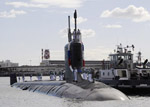New Products
Deepwater Communications
 |
For more information, visit: www.public.navy.mil/spawar/Press/Pages/07282010_PMW770.aspx
Enhanced Surveillance Video
Live, full-motion video from unmanned aircraft and other drones has become indispensable in military and intelligence operations, and quality imagery is essential to mission success. Any-Image-Anywhere (AIA), a new advanced image enhancement and routing system for full-motion video, combines high-performance parallel processing, high-speed video switching, and open architecture algorithms to enhance video imagery in real time and to allow any video source to be routed to any combination of displays. AIA processes multiple video streams at 30 frames per second in real time with zero latency; routes any video source through any number of processing algorithms and outputs the video stream to any monitor, network, recorder or similar device; provides the ability to route multiple sources to one monitor or to virtual screens within a monitor; allows for touch screen capability; and allows users to select new video streams on demand using virtual buttons.
For more information, visit: www.zmicro.com/aia
Rucksack Enhanced Portable Power System
In a never-ending quest to improve battery power capabilities on the battlefield while decreasing the weight carried on soldiers’ backs, the U.S. Army is deploying to Afghanistan 725 Rucksack Enhanced Portable Power Systems (REPPS). REPPS is a portable system that combines solar panels, connectors and adaptors and can charge most common military batteries for up to six hours. REPPS evolved from the Soldier Photovoltaic Portable Power Panel program but now provides a full spectrum of customer power options. Multiple REPPS systems can be linked together for charging devices that demand more power. The system untethers combat units from vehicle power or tactical operations centers. Specifically designed for silent watch operations and operations in remote areas, the system has already been used for surveillance and reconnaissance missions.
For more information, visit: http://bit.ly/d49RKp
 |
For more information, visit: www.nist.gov/eeel/optoelectronics/dark_081710.cfm




Comments